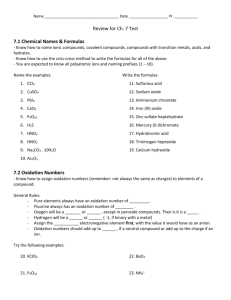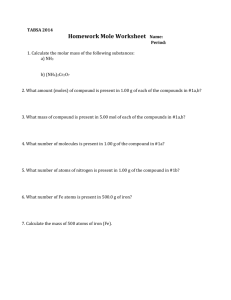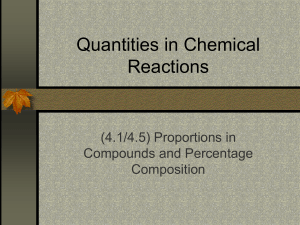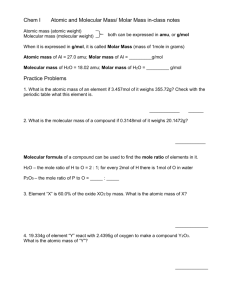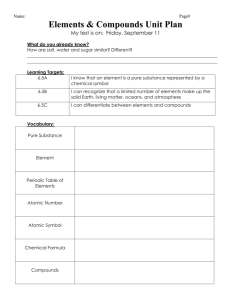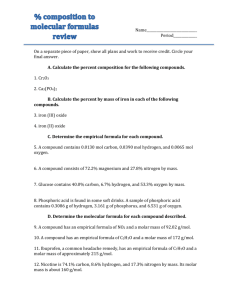YOU WILL FIND THIS LETTER ON MY WEBSITE UNDER
advertisement
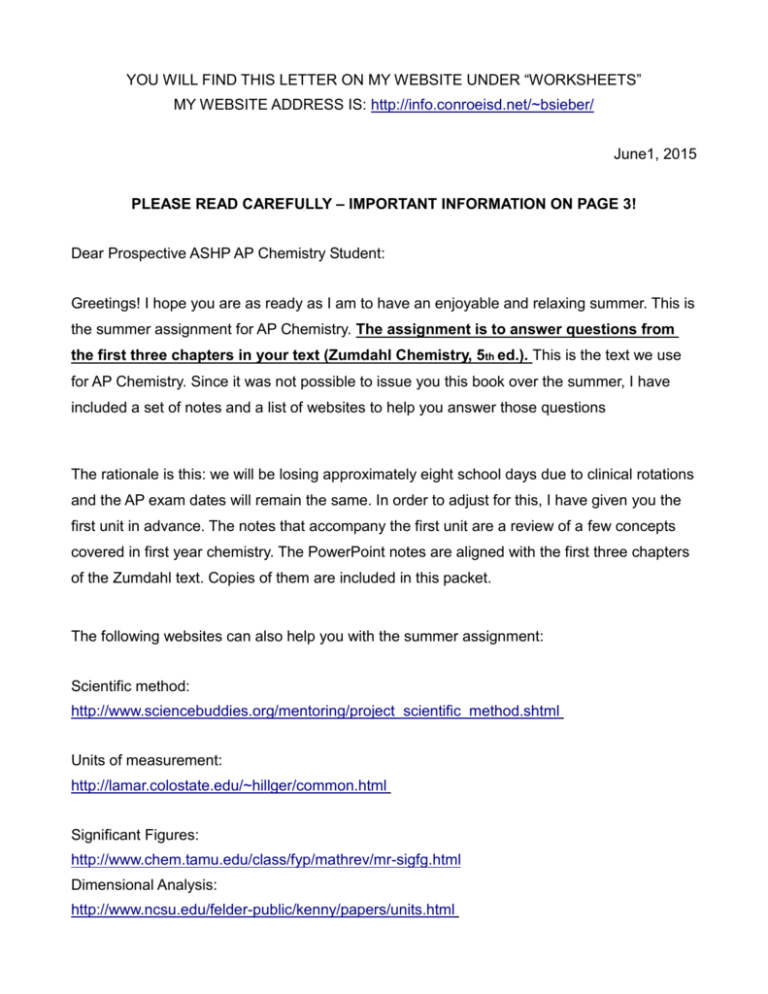
YOU WILL FIND THIS LETTER ON MY WEBSITE UNDER “WORKSHEETS” MY WEBSITE ADDRESS IS: http://info.conroeisd.net/~bsieber/ June1, 2015 PLEASE READ CAREFULLY – IMPORTANT INFORMATION ON PAGE 3! Dear Prospective ASHP AP Chemistry Student: Greetings! I hope you are as ready as I am to have an enjoyable and relaxing summer. This is the summer assignment for AP Chemistry. The assignment is to answer questions from the first three chapters in your text (Zumdahl Chemistry, 5th ed.). This is the text we use for AP Chemistry. Since it was not possible to issue you this book over the summer, I have included a set of notes and a list of websites to help you answer those questions The rationale is this: we will be losing approximately eight school days due to clinical rotations and the AP exam dates will remain the same. In order to adjust for this, I have given you the first unit in advance. The notes that accompany the first unit are a review of a few concepts covered in first year chemistry. The PowerPoint notes are aligned with the first three chapters of the Zumdahl text. Copies of them are included in this packet. The following websites can also help you with the summer assignment: Scientific method: http://www.sciencebuddies.org/mentoring/project_scientific_method.shtml Units of measurement: http://lamar.colostate.edu/~hillger/common.html Significant Figures: http://www.chem.tamu.edu/class/fyp/mathrev/mr-sigfg.html Dimensional Analysis: http://www.ncsu.edu/felder-public/kenny/papers/units.html Temperature: http://abyss.uoregon.edu/~js/glossary/temperature_scale.html http://chemunder.chemistry.ohio-state.edu/under/chemed/qbank/1/1-29/index.htm Density: http://www.elmhurst.edu/~chm/vchembook/120Adensity.html Classification of matter: http://www.emsb.qc.ca/laurenhill/science/classification.html http://www.fordhamprep.org/gcurran/sho/sho/lessons/lesson14.htm Law of Definite Proportions http://www.iscid.org/encyclopedia/Law_of_Definite_Proportions Law of Multiple Proportions http://www.factmonster.com/ce6/sci/A0829092.html Early Atomic Experiments Thomson’s Cathode Ray tube http://www.aip.org/history/electron/jjhome.htm Rutherford’ Atomic model http://www.daviddarling.info/encyclopedia/R/Rutherfords_experiment_and_atomic_model.html Nuclear structure http://web.jjay.cuny.edu/~acarpi/NSC/3-atoms.html Ionic and Molecular substances http://chemistry.twu.edu/tutorial/IonForSum.html http://chemistry.twu.edu/tutorial/molforsum.html Ball and stick models vs. space filling models http://dl.clackamas.cc.or.us/ch106-03/structur1.htm Periodic table http://www.dayah.com/periodic/ Chemical nomenclature – writing chemical formulas http://science.widener.edu/svb/pset/nomen_b.html Isotopes http://www.chemteam.info/Mole/AvgAtomicWt-Reverse.html http://www.chemteam.info/Mole/AverageAtomicWeight.html Molar mass and mole conversions http://www.fordhamprep.org/gcurran/sho/sho/lessons/lesson92.htm Percent composition http://pages.towson.edu/ladon/empiric.html Even though you won’t have your AP text, I don’t anticipate you should have much difficulty in answering these questions. Don’t forget that I can help you if you have any questions regarding your summer assignment or the course in general. My email address is bsieber@conroeisd.net. IMPORTANT: THE ASSIGNMENT WILL BE DUE ON THE SECOND DAY OF CLASS: AUGUST 25, 2015. PLACE ANSWERS ON SEPARATE PAPER. IFA CALCULATION IS REQUIRED, SHOW WORK FOR THE CALCULATION. WRITE IN COMPLETE SENTENCES WHERE APPROPRIATE. ENJOY YOUR SUMMER! Thank you, Mr. Sieber ZUMDAHL – CHAPTER ONE QUESTIONS 16. Define and explain the differences between the following terms. a. law and theory b. theory and experiment c. qualitative and quantitative d. hypothesis and theory 17. Is the scientific method suitable for solving problems only in the sciences? Explain. 19. Explain why the uncertainty of measurement depends on the precision of the measuring of the measure device. Give an example to illustrate. 21. Distinguish between physical changes and chemical changes. 23. Which of the following are exact numbers? a. The elevation of Breckenridge, Colorado is 9,600 feet b. There are 12 eggs in a dozen c. One yard is equal to 0.9144 m. d. The announced attendance at a football game was 52,806 m e. In 1983, 1759 Ph.D.s in chemistry were awarded in the United States f. The budget deficit of the U.S. government in fiscal year 1990 was $269 billion. 25. How many significant figures are in each of the following: a. 12 b. 1098 c. 2001 d. 2.001 x 10-3 e. 0.0000101 f. 1.01 x 10-5 g. 1000. h. 22.04030 27. Round off each of the following numbers to three significant figures, and write the answer in standard exponential notation. a. 312.54 b. 0.00031254 c. 31254000 d. 0.31254 29. Perform the following mathematical operations, and express each result to the correct number of significant figures. a. 97.381 + 4.2502 + 0.99195 b. 171.5 + 72.915 – 8.23 c. 1.00914 + 0.87104 + 1.2012 d. 21.901 – 13.21 – 4.0215 31. Perform the following mathematical operations, and express each result to the correct number of significant figures. a. 4.184 x 100.62 x (25.27 – 24.16) b. 8.925 – 8.904/8.925 x 100 (This type of calculation is done many times in calculating a percentage error. Assume that this example is such a calculation: thus 100 can be considered to be an exact number.) c. (9.04 – 8.23 + 21.954 + 81.0) / 3.1416 d. 9.2 x 100.65 / 8.3221 + 4.026 e. 0.1654 + 2.07 – 2.114 f. 8.27(4.987 – 4.962) g. 9.5 + 4.1 + 2.8 + 3.175 / 4 (Assume that this operation is taking the average of four numbers. Thus 4 in the denominator is exact). h. 9.025 – 9.024 / 9.025 x 100 (100 is exact) 33. Perform each of the following conversions. a. 8.43 cm to millimeters b. 2.41 x 102 cm to meters c. 294.5 nm to centimeters d. 1.445 x 104 m to kilometers e. 235.3 m to millimeters f. 903.3 nm to micrometers 35. Many atomic dimensions are expressed in angstroms. (1 Å = 1 x 10 -8 cm). What is the angstrom equal to in terms of the SI units nanometer (nm) and picometer (pm)? 37. Perform the following unit conversions: a. Congratulations! You and your spouse are the proud parents of a new baby, born while you are studying in a country that uses the metric system. The nurse has informed you that the baby weighs 3.91 kg and measures 51.4 cm. Convert your baby’s weight to pounds and ounces and her length (rounded to the nearest quarter inch). 45. You’re planning to buy a new car. One model that you’re considering gets 32 miles to a gallon gasoline in highway travel. The one that your spouse likes gets 14 kilometers to the liter. Which car has the better gas mileage? 47. A person has a temperature of 102.5oF. What is the temperature on the Celsius scale? On the Kelvin scale? 49. Many chemical quantities are specified as being measured at 25oC. What is this temperature on the Fahrenheit scale? On the Kelvin scale? 51. A thermometer gives a reading of 20.6oC ± 0.1 oC. What is the temperature in oF? What is the uncertainty? 53. The density of aluminum is 2.70 g/cm3. Express this value in units of kilograms per cubic meter and pounds per cubic foot. 55. A star is estimated to have a mass of 2 x 1036 kg. Assuming it to be a sphere of average radius 7.0 x 105 km, calculate the average density of the star in units of grams per cubic centimeter. 63. What are some of the differences between a solid, a liquid, and a gas? 65. Classify each of the following as a mixture or a pure substance. a. water b. blood c. the oceans d. iron e. brass f. uranium g. wine h. leather i. table salt (NaCl) Of the substances, which are elements and which are compounds? 83. A rule of thumb in designing experiments is to avoid using a result that is the small difference between two large measured quantities. In terms of uncertainties in measurement, why is this good advice? ZUMDAHL – CHAPTER TWO QUESTIONS 15. Use Dalton’s atomic theory to account for each of the following: a. The law of conservation of mass b. The law of definite proportion c. The law of multiple proportions 16. What refinements had to be made in Dalton’s atomic theory to account for Gay-Lussac’s results on the combining volumes of gases? 17. What evidence led to the conclusion that cathode rays had a negative charge? 18. What discoveries were made by J. J. Thomson, Henri Bequerel, and Lord Rutherford? How did Dalton’s model of the atom have to be modified to account for these discoveries? 19. What is the distinction between atomic number and mass number? Between mass number and atomic mass? 20. Distinguish between the terms family and period in connection with the periodic table. For which of these terms is the term group also used? 21. When hydrogen is burned in oxygen to form water, the composition of water formed does not depend on the amount of oxygen. Interpret this in terms of the law of definite proportions. 22. The two most reactive families of elements are the halogens and the alkali metals. How do they differ in their reactivities? 23. When mixtures of gaseous H2 and gaseous Cl2 react, a product forms that has the same properties regardless of the relative amounts of H2 and Cl2 used. a. How is this result interpreted in terms of the law of definite proportions? b. When a volume of H2 reacts with an equal volume of Cl2 at the same temperature and pressure, what volume of product having the formula HCl is formed? 24. A reaction of 1 liter of chlorine gas, (Cl2) with 3 liters of fluorine gas (F2) yields 2 liters of gaseous product. All gas volumes are at the same temperature and pressure. What is the formula of the gaseous product? 25. Several compounds containing only sulfur (S) and fluorine (F) are known. Three of them have the following compositions: i. 1.188 g of F for every 1.000 g of S ii. 2.375 g of F for every 1.000 g of S iii. 3.56 3 g of F for every 1.000 g of S How do these data illustrate the law of multiple proportions? 26. Hydrazine, ammonia, and hydrogen azide all contain only nitrogen and hydrogen. The mass of hydrogen that combines with 1.00 g of nitrogen for each compound is 1.44 x 10 -1 g, 2.16 x 10-1 g, and 2.40 x 10-2 g, respectively. Show how these data illustrate the law of multiple proportions. 27. Early tables of atomic weights (masses) were generated by measuring the mass of a substance that reacts with 1.00 g of oxygen. Given the following data and taking the atomic mass of hydrogen as 1.00, generate a table of relative atomic masses for oxygen, sodium, and magnesium. Element Mass that combines with 1.00 g Oxygen Assumed formula Hydrogen 0.126 g HO Sodium 2.875 g NaO Magnesium 1.500 g MgO 29. After researching information on the mass of the proton, the mass of the electron, and the sizes of the nucleus and the atom, calculate the densities of a hydrogen nucleus and hydrogen atom. 30. If you wanted to make an accurate scale model of the hydrogen atom and decided that the nucleus would have a diameter of 1 mm, what would be the diameter of the entire model? 39. List the noble gas elements. Which of the noble gases has only radioactive isotopes? 41. In the periodic table, how many elements are found in a. The second period? b. The third period? c. The fourth period? d. Group 5A? 43. How many protons and neutrons are contained in the nucleus of each of the following atoms? In an atom of each element how many electrons are present? a. Pu – 238 b. He – 4 c. Cu – 65 d. Co – 60 e. Cr – 52 f. Cr - 54 45. An atom has 9 protons and 10 neutrons in the nucleus. What is its symbol? 47. What is the symbol for an ion with 63 protons, 60 electrons, and 88 neutrons? 49. What is the symbol of an ion with 16 protons, 18 neutrons, and 18 electrons? 53 . Classify the following elements as metals or nonmetals: a. Mg d. Si g. Rn j. Ti b. Ge e Eu h. Au k. B c Am f. Bi i. At l. Br 55. Which of the following sets of elements are all in the same group in the periodic table? a. Fe, Ru, Os c. Sn, As, S b. Rh, Pd, Ag d. Se, Te, Po 57. Consider the elements of Group 4A (the “carbon family”): C, Si, Ge, Sn, and Pb. What is the trend in metallic character as one goes down this group? 59. Would you expect each of the following atoms to gain or lose electrons when forming ions? What ion is the most likely in each case? a. Na c. Ba e. Al b. Sr d. I f. S 61. Name each of the following compounds: a. NaCl b. Rb2O c. CaS d. AlI3 63. Name each of the following compounds: a. CrO3 c. Al2O3 e. CaBr2 b. Cr2O3 d. NaH f. ZnCl2 65. Name each of the following compounds: a. KClO4 c. Al2(SO4)3 b. Ca3(PO4)2 d. Pb(NO3)2 67. Name each of the following compounds: a. NI3 c. SF2 b. PCl3 d. N2F4 69. Name each of the following compounds: a. CuI f. S4N4 b. CuI2 g. SF6 c. CoI2 h. NaOCl d. Na2O3 i. BaCrO4 e. NaHCO3 k. NH4NO3 71. Write the formula for each of the following compounds: a. cesium bromide e. silicon Tetrachloride b. barium sulfate f. chlorine trifluoride c. ammonium chloride g. beryllium oxide d. chlorine monoxide h. magnesium fluoride 73. Write the formula for each of the following compounds: a. Sodium oxide g. lead(IV) sulfide b. Sodium peroxide h. copper(I) chloride c. Potassium cyanide i. gallium arsenide d. Copper(II) nitrate j. cadmium selenide e. Silicon tetrachloride k. zinc sulfide f. Lead(II) sulfide ZUMDAHL – CHAPTER THREE QUESTIONS 21. The element Magnesium (Mg) has three stable isotopes with the following masses and abundances: Istotope Mass (amu) Abundance 24Mg 23.9850 78.99% 25Mg 24.9858 10.00% 26Mg 25.9826 11.01% 23. An element is a mixture of two isotopes. One isotope of an element has an atomic mass of 34.96885 amu and has a relative abundance of 75.53%. The other isotope has an atomic mass of 36.96590 amu. Calculate the average atomic mass and identify the element. 25. The element Europium exists in nature as two isotopes: 151Eu has a mass of 150.9196 amu, and 153Eu has a mass of 151.96 amu. Calculate the relative abundance of the two europium isotopes. 29. Calculate the mass of 500. atoms of iron (Fe) 31. Diamond is a natural form of pure carbon. How many atoms of carbon are in a 1.00-carat diamond (1.00 carat = 0.200 g)? 33. Aluminum metal is produced by passing an electric current through a solution of aluminum oxide (Al2O3) dissolved in molten cryolite (Na3AlF6). Calculate the molar masses of Al2O3 and Na3AlF6. 35. Calculate the molar mass of the following substances. a. NH3 b. N2H2 c. (NH4)2Cr2O7 37. How many moles of compound are present in 1.00 g of each of the compounds in Exercise 35? 39. How many grams of compound are present in 5.00 mol of each of the compounds in Exercise 35? 41. How many grams of Nitrogen are present in 5.00 mol of each of the compounds in Exercise 35? 43. How many molecules (or formula units) are present in 1.00 g of each of the compounds in Exercise 35? 47. Ascorbic acid, or vitamin C (C6H8O6), is an essential vitamin. It cannot be stored by the body and must be present in the diet. What is the molar mass of ascorbic acid? Vitamin C tablets are taken as a dietary supplement. If a typical tablet contains 500.0 mg of vitamin C, how many moles and how many molecules of Vitamin C does it contain? 49. How many moles are represented by each of these samples? a. 100 molecules (exactly) of H2O b. 100.0 g H2O c. 150 molecules (exactly) of O2 51. Determine the mass in grams of the following: a. 3.00 x 1020 N2 molecules b. 3.00 x 10-3 mol N2 c. 1.5 x 102 mol N2 d. A single N2 molecule 53. Aspartame is an artificial sweetner that is 160 times sweeter than sucrose (table sugar) when dissolved in water. It is marketed as Nutra-Sweet. The molecular formula of aspartame is C14H18N2O5. a. Calculate the molar mass of aspartame. b. How many moles of molecules are present in 10.0 g aspartame? c. Calculate the mass in grams of 1.56 mol aspartame. d. How many molecules are in 5.0 mg aspartame? e. How many atoms of nitrogen are in 1.2 g aspartame? f. What is the mass in grams of 1.0 x 109 molecules of aspartame? g. What is the mass in grams of one molecule of aspartame? 55. Photocells use a semiconducting material that produces an electric current or a change in resistance on exposure to light. Compounds of cadmium (Cd) combined with an element from Group 6A of the periodic table are used in many common photocells. Calculate the mass percent of Cd in CdS, CdSe, and CdTe. 57. In 1987 the first substance to act as a superconductor at a temperature above that of liquid nitrogen (77K) was discovered. The approximate formula fo the substance is YBa2Cu3O7. Calculate the percent composition by mass of this material. 59. Arrange the following substances in order of increasing mass percent of carbon: a. caffeine, C8H10N4O2 b. sucrose, C12H22O11 c. ethanol, C2H5OH 63. Express the composition of each of the following compounds as the mass percents of its elements. a. formaldehyde, CH2O b. glucose, C6H12O6 c. acetic acid HC2H3O2 65. Give the empirical formula for each of the following compounds for which the common names are given. a. vitamin C, C6H8O6 b. benzene, C6H6 c. acetylene, C2H2 d. phosphorus pentoxide, P4O10 e. glucose, C6H12O6 f. acetic acid, HC2H3O2 67. One of the most commonly used white pigments in paint is a compound of titanium and oxygen that contains 59.9% Ti by mass. Determine the empirical formula of this compound. 71. A compound that contains only nitrogen and oxygen is 30.4$ N by mass; the molar mass of the compound is 92 g/mol. What is the empirical formula of the compound? What is the molecular formula of the compound? 73. Benzene contains only carbon and hydrogen and is 7.74% H by mass; the molar mass of benzene is 78.1 g/mol. Determine the empirical and molecular formulas of benzene. 79. Write a balanced chemical equation that describes each of the following: a. Iron metal reacts with oxygen to form rust, iron (III) oxide. b. Calcium metal reacts with water to produce aqueous calcium hydroxide and hydrogen gas. c. Aqueous barium hydroxide reacts with aqueous sulfuric acid to produce solid barium sulfate and water. 81. Balance the following equations: a. Cu(s) + AgNO3 (aq) → Ag(s) + Cu(NO3)2 (aq) b. Zn (s) + HCl (aq) → ZnCl2 (aq) + H2(g) c. Au2S3(s) + H2(g) → Au (s) + H2S (g) 83. Balance the following equations representing combustion reactions: a. C12H22O11 (s) + O2 (g) → CO2 (g) + H2O (g) b. C6H6 (l) + O2 (g) → CO2 (g) + H2O (g) c. Fe (s) + O2 (g) → Fe2O3 (s) d. C4H10 (g) + O2 (g) → CO2 (g) + H2O (g) e. FeO (s) + O2 (g) → Fe2O3 (s) 91. The reusable booster rockets of the U.S. space shuttle employ a mixture of aluminum and ammonium perchlorate for fuel. A possible equation for this reaction is 3Al (s) + 3NH4ClO4 (s) → Al2O3 + AlCl3 (s) + 3 NO (g) + 6H2O (g) What mass of NH4ClO4 should be used in the fuel mixture for every kilogram of Al? 93. Coke is an impure form of carbon that is often used in the industrial production of metals from their oxides. If a sample of coke is 95% carbon by mass, determine the mass of coke needed to react completely with 1.0 ton of copper (II) oxide. 2CuO (s) + C (s) → 2Cu (s) + CO2 (g) 95. The compound cisplatin, Pt(NH3)2C12, has been studied extensively as an antitumor agent. a. Calculate the elemental percent composition by mass of cisplatin. b. Cisplatin is synthesized as follows: K2PtCl4 (aq) + 2NH3 (aq) → Pt(NH3)2Cl2(s) + 2KCl(aq) What mass of cisplatin can be made from 100. g of K2PtCl4 and sufficient NH3? What mass of KCl is also produced? 97. Consider the reaction Mg (s) + I2 (s) → MgI2 (s) Identify the limiting reacgen in each of the reaction mixtures below: a. 100 atoms of Mg and 100 molecules of I2 b. 150 atoms of Mg and 100 molecules of I2 c. 200 atoms of Mg and 300 molecules of I2 d. 0.16 mol Mg and 0.25 mol I2 e. 0.14 mol Mg and 0.14 mol I2 f. 0.12 mol Mg and 0.08 mol I2 g. 6.078 g Mg and 63.46 g I2 h. 1.00 g Mg and 2.00 g I2 i. 1.00 g Mg and 20.00 g I2 99. When a mixture of silver metal and sulfur is heated, silver sulfide is formed: 16Ag (s) + S8(s) → 8Ag2S (s) a. What mass of Ag2S is produced from a mixture of 2.0 g Ag and 2.0 g S8? b. What mass of which reactant is left unreacted? 101. Consider the following unbalanced equation: Ca3(PO4)2 (s) + H2SO4 (aq) → CaSO4 (s) + H3PO4 (aq) What masses of calcium sulfate and phosphoric acid can be produced from the reaction of 1.0 kg calcium phosphate with 1.0 kg concentrated sulfuric acid (98% H 2SO4 by mass)? 105. Aluminum burns in bromine, producing aluminum bromide: 2Al(s) + 3Br2 (l) → 2AlBr3 (s) In a certain experiment, 6.0 g of aluminum was reacted with an excess of bromine to yield 50.3 g aluminum bromide. Calculate the theoretical and percent yields for this experiment.
